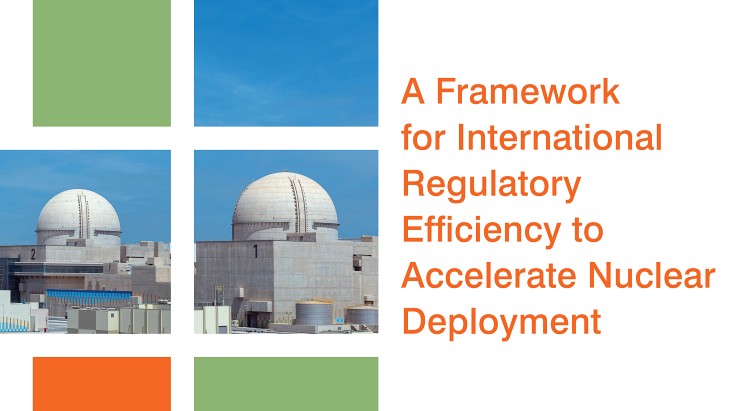Nuclear groups propose ‘stepwise’ approach to increased regulatory efficiency
22 September 2023
A new joint report from World Nuclear Association, the Nuclear Energy Institute and the Canadian Nuclear Association proposes regulatory steps which can be taken to minimise the time and cost for large-scale deployment of a fleet of standardised reactor designs that are acceptable in multiple countries around the world.
 (Image: World Nuclear Association)
(Image: World Nuclear Association)The report, A Framework for International Regulatory Efficiency to Accelerate Nuclear Deployment, says changes are required if there is going to be the scale of new nuclear required to tackle climate change and energy security concerns.
It proposes a step-by-step approach "given the complexity of the differences in regulations and standards, including technical, human and cultural challenges and how difficult this makes convergence" of regulatory requirements in different countries.
Its model is for "gradually increasing collaboration between key stakeholders that is supported by multilateral agreements between technology vendors, regulators, and operators", and proposes to "build upon the efforts of small groups of regulators and industry jointly working on the review of specific reactor designs to increase efficiency in the design reviews to facilitate the ability of one regulator to leverage all, or part, of the outcomes from reviews undertaken by other regulators to support their own regulatory process".
Its three key recommendations for action are:
- Increased support from governments, regulators and industry "to facilitate collaborative regulatory design review activities, including the enabling of groups of regulators working on specific designs"
- Stakeholders to facilitate "increased collaborative regulatory design reviews" through a stepwise phased approach, which would allow near-term benefits through “low risk activities" while building a foundation for greater benefits that need a longer timeframe
- Increased coordination of existing harmonisation activities "to accelerate progress through the stepwise phased approach and make most effective use of the resources available".
The report, produced by World Nuclear Association's Cooperation in Reactor Design Evaluation and Licensing (CORDEL) working group in cooperation with the Canadian Nuclear Association (CNA) and the Nuclear Energy Institute (NEI), builds on existing work such as the Multinational Design Evaluation Programme and the International Atomic Energy Agency's Nuclear Harmonization and Standardization Initiative which was launched last year.
"These initiatives and others, including from other industries, have demonstrated that there is much that can be, and has been, achieved through collaborative efforts between different regulators and with industry. What is clear from other industries and ongoing harmonisation activities is that support from governments and early alignment among key stakeholders are important prerequisites for success," the report says.
It also says that "working with large groups of stakeholders makes alignment of requirements increasingly difficult, and that working generically on design safety issues makes it difficult to identify the real challenges to joint design reviews".
It concludes that to meet the targets for new nuclear by 2050, there needs to be an "innovative approach" and says "the collaboration efforts will require additional resources above and beyond what each national regulator already needs to support short-term regulatory activities in their own countries".
"The aim of committing resources and efforts to these international collaborative efforts now is to support increased export markets and facilitate national regulators being able in future to carry out more reviews more efficiently."
World Nuclear Association Director General Sama Bilbao y León said the report "highlights how increased government support for multi-lateral regulatory review activities, and greater coordination between international organisations are essential to accelerate the global deployment of fleets of standardised reactor designs. To be successful, we must come together as a nuclear sector, set common goals, define ambitious yet realistic targets, and collaborate to deliver the benefits of nuclear energy for all".
John Gorman, President and CEO of the CNA, said: "This report paves the way for the nuclear industry and regulators across the world as a blueprint towards a common objective and will prove to be a building block of initiatives such as the recently launched Net Zero Nuclear."
Maria Korsnick, President and CEO at NEI, said: "The demand for new nuclear is real, and there's a clear consensus on the world stage that nuclear plays a crucial role in our global clean energy transition. We cannot tackle the climate threat and bolster energy security without the versatility, reliability, and affordability that clean nuclear power ensures. But the challenge before us isn’t demand - it is meeting demand. Now is the time to rise to the occasion. Together, with our global allies, we can face the challenge before us through modernised and globally streamlined regulatory approaches, while maintaining our high standards of safety."
Researched and written by World Nuclear News
 How the completed site could look (Image: NRG-Pallas)
How the completed site could look (Image: NRG-Pallas).jpg?ext=.jpg) The site of the plant's former containment building (Image: Enresa)
The site of the plant's former containment building (Image: Enresa).jpg)
.jpg)
.jpg?ext=.jpg) The companies' vision for their concept (Image: Crowley)
The companies' vision for their concept (Image: Crowley).jpg?ext=.jpg) The PCAT replica installed and ready for testing at Creative Energy's facility (Image: DOE Office of Nuclear Energy)
The PCAT replica installed and ready for testing at Creative Energy's facility (Image: DOE Office of Nuclear Energy).jpg?ext=.jpg)
.jpg?ext=.jpg) From left: US Ambassador to Poland Mark Brzezinski, Ahmet Tokpinar, general manager of Bechtel’s nuclear power business line, Elias Gedeon, Senior Vice President for Commercial Operations at Westinghouse, Miroslaw Kowalik, President, Westinghouse Poland, and Anna Łukaszewska-Trzeciakowska, Poland Government Plenipotentiary for Strategic Energy Infrastructure at the signing ceremony (Image: Westinghouse)
From left: US Ambassador to Poland Mark Brzezinski, Ahmet Tokpinar, general manager of Bechtel’s nuclear power business line, Elias Gedeon, Senior Vice President for Commercial Operations at Westinghouse, Miroslaw Kowalik, President, Westinghouse Poland, and Anna Łukaszewska-Trzeciakowska, Poland Government Plenipotentiary for Strategic Energy Infrastructure at the signing ceremony (Image: Westinghouse)



